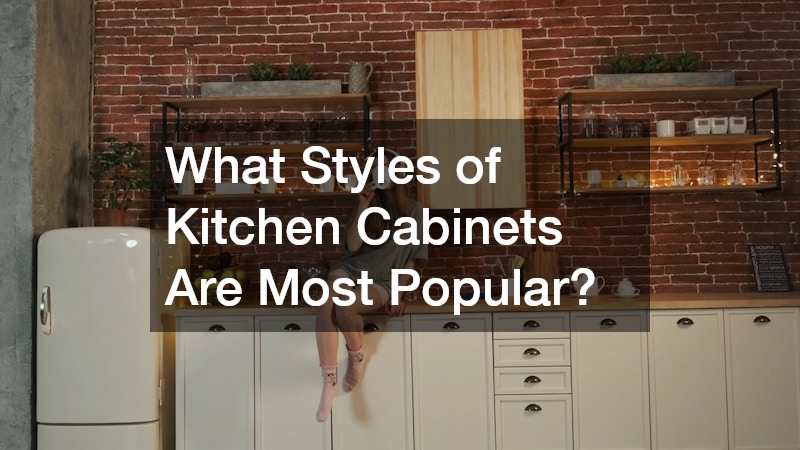When renovating or building a kitchen, one of the most impactful decisions you’ll make is choosing the right style of kitchen cabinets. These foundational elements are not just storage solutions but visual anchors that define the entire aesthetic of your space.
In Australia, where open-plan living and contemporary finishes are highly valued, homeowners are increasingly turning to cabinet styles that blend function with modern flair. From timeless classics to sleek innovations, the most popular kitchen cabinet styles reflect a blend of practicality, personality and design influence from around the world.
Shaker Cabinets: Classic & Versatile
Shaker-style cabinets have long held a dominant position in Australian kitchen design and for good reason. Their clean lines, square edges and minimalist detailing create a style that can suit everything from traditional homes to modern spaces. Typically made of timber or medium-density fibreboard (MDF) with a recessed panel, shaker cabinets offer a blank canvas that can be adapted with different colours, hardware and finishes.
One of the reasons shaker kitchen cabinets remain so popular is their ability to balance simplicity and elegance. They don’t overwhelm the kitchen with detail, yet they carry a refined presence that elevates the space. Painted white shaker cabinets are a common sight in coastal or Hamptons-style kitchens, while darker tones such as navy, charcoal or forest green are used to introduce a dramatic or moody effect in more contemporary layouts.
Flat-Panel Cabinets: Sleek & Streamlined
Flat-panel cabinets, also known as slab cabinets, represent the epitome of modern design. With a smooth, uninterrupted surface and no visible framing or embellishments, they are particularly suited to minimalist or Scandinavian-style kitchens. Their streamlined appearance makes them a popular choice for homeowners who want to achieve a seamless, uncluttered look.
In Australian homes, flat-panel kitchen cabinets often come in high-gloss finishes, matte laminates or even timber veneers, allowing for a variety of textures that can match any interior palette. These cabinets work well with handle-less designs, where push-to-open mechanisms or integrated finger pulls keep the surface looking pristine. The result is a kitchen that feels open, contemporary and highly functional.
Glass-Front Cabinets: A Touch of Transparency
For those looking to introduce a sense of openness and visual interest, glass-front cabinets offer a stylish solution. Often used for upper cabinetry or display areas, these cabinets allow homeowners to showcase glassware, ceramics or décor items while maintaining a tidy and organised look.
In many Australian homes, glass-front kitchen cabinets are used selectively rather than throughout the entire kitchen. This selective placement helps break up a wall of solid doors and adds a sense of depth. Whether paired with traditional frames or modern flat panels, glass-front designs are ideal for adding character and charm.
Open Shelving: A Contemporary Twist
While technically not a cabinet, open shelving has gained popularity as a complement to conventional cabinetry. More and more Australians are embracing the look of exposed shelves to store frequently used items or display stylish kitchenware. This trend, often associated with industrial, boho or farmhouse-style kitchens, provides a sense of accessibility and openness.
Open shelving is commonly installed above countertops or in alcoves where wall cabinets might otherwise feel too bulky. It works well when balanced with closed cabinetry below the bench line, ensuring that the kitchen maintains adequate concealed storage while still appearing spacious. Timber shelves are especially favoured, offering warmth and texture that contrast beautifully with neutral-toned kitchen cabinets.
Handleless & Integrated Designs: The Ultimate in Modern Sophistication
Modern Australian kitchens are increasingly adopting handleless cabinetry, where the focus is on sleek finishes and integrated hardware. These styles include recessed finger pulls, push-to-open mechanisms or continuous rails that allow for easy access without the need for protruding handles.
This design trend supports the growing preference for contemporary minimalism and helps create a clean, continuous flow throughout the kitchen. Integrated appliances, such as fridges and dishwashers concealed behind matching cabinet panels, further enhance the sense of cohesion. These kitchens often favour a monochromatic or muted colour scheme, allowing materials like concrete, marble and timber to shine.
Two-Tone Cabinets: Adding Contrast & Depth
Another trend gaining traction in Australian homes is the use of two-tone kitchen cabinets. This approach introduces visual interest by combining different colours, textures or materials within the same cabinetry layout. A common combination involves using darker cabinetry for lower units and lighter shades for upper cupboards, creating a balanced and dynamic aesthetic.
Two-tone cabinets allow for personalisation without overwhelming the space. For example, pairing soft sage green lower cabinets with white upper units introduces warmth and personality while keeping the overall look bright and airy. The dual-tone approach also helps delineate different zones within open-plan living areas, enhancing both style and function.
Choose Cabinets That Complement Your Lifestyle
The most popular styles of kitchen cabinets in Australia today reflect a diverse blend of timeless elegance and modern innovation. Whether you’re drawn to the clean lines of shaker cabinets, the bold minimalism of flat panels or the open-air feel of shelving, your choices should ultimately reflect how you live and interact within your kitchen.
Kitchen cabinets are more than storage—they are the cornerstone of your kitchen’s personality. As trends evolve, versatility, functionality and aesthetic harmony continue to guide the selection process. By understanding the strengths and characteristics of each style, homeowners can make informed choices that bring both visual appeal and everyday convenience to the heart of their home.
.

